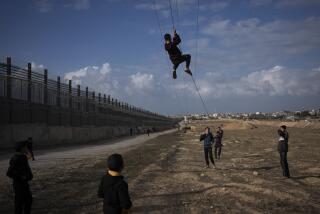Dig in Sinai Uncovers Roman Amphitheater : Archeology: A canal project, which follows the path of an ancient route linking Africa and Asia, threatens more than 1,000 antiquity sites with obliteration.
- Share via
PELUSIUM, Egypt — Egyptian archeologists have unearthed an amphitheater and racetrack of Pelusium, a major Roman seaport and early Christian center on the Mediterranean coast of Sinai.
They expect the discoveries to make Pelusium, 15 miles east of the Suez Canal, a leading tourist attraction in coming years.
Not far from the latest finds, archeologists are trying to stay ahead of the bulldozers carving out a canal system that will transform thousands of acres of Sinai desert into farmland.
Teams from Germany, France, Britain, Switzerland, Austria and Canada will join the effort next month. The United States is providing equipment and technical aid.
The canal project, which follows the path of an ancient route linking Africa and Asia, threatens more than 1,000 antiquity sites with obliteration.
“I’m not surprised there are such discoveries, because so many important sites lie along the path of this canal,” Faiza Heikal, Egyptology professor at American University in Cairo, said of Pelusium. “But it’s always very exciting when pieces of history emerge.”
Heikal heads an international campaign to save Sinai’s heritage.
The Salam Canal, envisioned by the late President Anwar Sadat, will carry water piped from the Nile Delta under the Suez Canal across 100 miles of Sinai to El-Arish, near the Israeli border. It could irrigate up to 600,000 acres of desert along the route.
For archeologists, the project is a blessing as well as a curse because it focuses attention on historical treasures long overshadowed by the splendid pyramids, temples and tombs along the Nile.
So far, they have managed to stay about a mile ahead of the bulldozers.
After the canal is finished, many sites not directly along it will be threatened by fluctuating water levels and an expected influx of 300,000 settlers.
Remains of Pelusium stretch for almost 2 miles between the routes of the main canal and a drainage ditch to the north. Slender columns, human bones, Roman glass and red bricks stud the dunes and salt flats.
Last year, archeologists began digging near a haphazard collection of two dozen columns and bits of columns outside a towering fortress built during the Islamic period.
They are gradually uncovering the amphitheater, complete with tiers of red brick seats and a circular stage of bricks covered by limestone chips assembled like a mosaic. The theater, 300 feet in diameter, faces the sea.
Several miles away, another Egyptian team is excavating a large circle of red bricks identified as the grandstand where spectators enjoyed a day at the races in Pelusium’s hippodrome.
Mohammed Abdel Maksoud, who coordinates archeological work for Heikal’s salvage campaign, said ancient records speak of Pelusium’s beauty.
“They called this place the island of Pelusium, but until we started digging, we didn’t know why,” he said.
As Maksoud explained it, Pelusium would have looked like an island: “To the south was a branch of the Nile, to the north the Mediterranean, in the middle Pelusium.”
One of his many challenges is to reconstruct the plan of the city. Pelusium was second in size and importance only to Alexandria during Roman rule in Egypt, which began with the suicide of Cleopatra.
Excavators have uncovered a Roman bath with mosaic floors, a smaller amphitheater and bath, two churches, a monastery and a large storage area near the hippodrome, perhaps for grain.
Maksoud believes a major temple is buried somewhere in the area. Also, Pelusium is known to have been home to one of early Christianity’s most important sites, the Church of the Holy Family.
Sinai’s northern coastal strip was a highway between Egypt and Canaan. On it, Pharaohs marched against Palestinian princes and armies from Persia, Greece and Rome marched against Pharaohs.
Legend says the Holy Family traveled the route by donkey, with King Herod’s troops close behind.
That flight from Palestine to Egypt, and back, became a cornerstone of the Egyptian Coptic faith. The Copts built churches to mark important stages of the journey.
During the Israeli occupation of Sinai after the 1967 Middle East war, archeologist Elizer Oren of Ben Gurion University documented 1,300 antiquity sites along the coast. He did not excavate Pelusium because its ruins lay within a security zone facing the Suez Canal.
French teams came to Pelusium in the 1980s after Israel had returned Sinai to Egypt.
More to Read
Sign up for Essential California
The most important California stories and recommendations in your inbox every morning.
You may occasionally receive promotional content from the Los Angeles Times.













